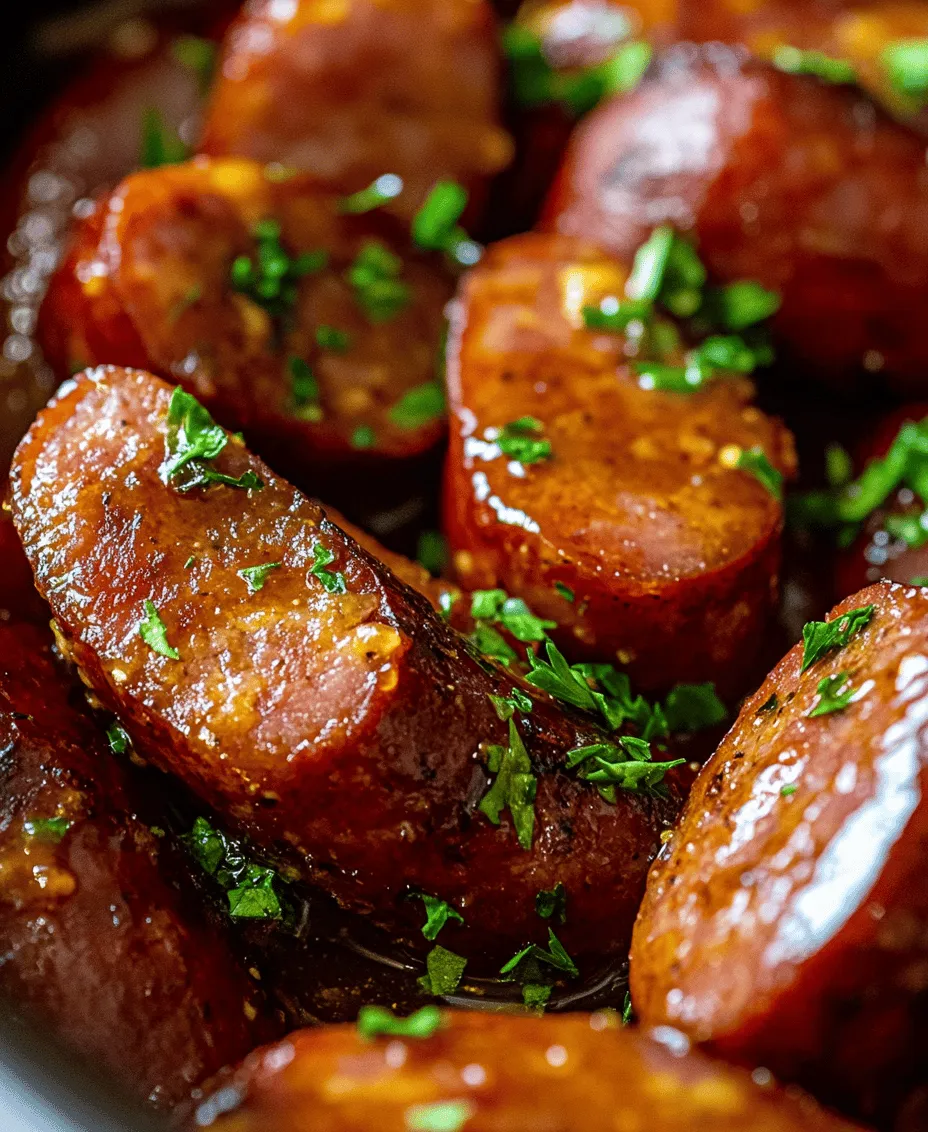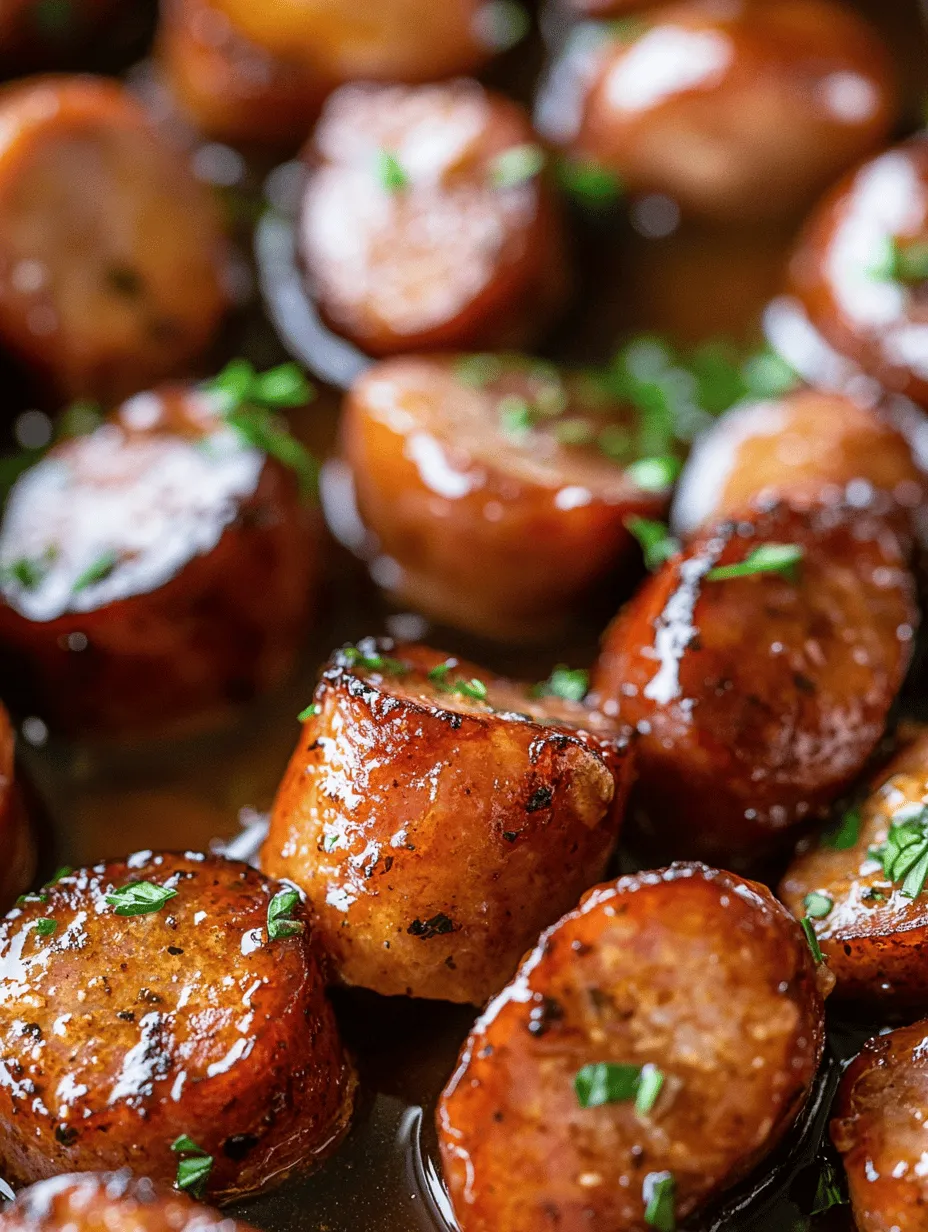Introduction
Kielbasa, the beloved sausage of Eastern European cuisine, has captured the hearts and taste buds of many around the globe. Originating from Poland, this savory delight is known for its rich flavor and versatility, making it an essential ingredient in various dishes. From hearty stews to grilled masterpieces, kielbasa serves as a delightful centerpiece that brings families and friends together around the dinner table.
What truly sets kielbasa apart is its ability to harmonize with a range of flavors, particularly the enchanting combination of sweet and savory. This balance creates a culinary experience that tantalizes the palate and elevates any meal. Whether you’re hosting a lively gathering or enjoying a cozy night in, our recipe for Sweet & Savory Kielbasa is the perfect choice to impress your guests or satisfy your cravings.
This dish is not only delicious but also remarkably simple to prepare. With a few key ingredients and straightforward steps, even novice cooks can create a mouthwatering dish that showcases the wonderful attributes of kielbasa. Join us on this culinary adventure as we explore the nuances of this beloved sausage and how to transform it into a delightful sweet and savory sensation.
Understanding Kielbasa
Definition and History of Kielbasa
The term “kielbasa” translates to “sausage” in Polish, but it encompasses a wide variety of sausages, each with its unique taste and preparation. Traditionally, kielbasa is made from pork, beef, or a combination of meats, seasoned with spices such as garlic, marjoram, and pepper. Its history dates back centuries, where it was first crafted by skilled Polish artisans who took pride in their craft. Kielbasa has since become a staple in Polish households and is often served at celebrations, family gatherings, and festive occasions.
Kielbasa’s significance extends beyond just its flavor; it represents Polish culture and heritage. In Poland, it’s common to find kielbasa served during Christmas, Easter, and other important holidays, where it plays a key role in traditional meals. The history of kielbasa is intertwined with the evolution of Polish cuisine, showcasing how this humble sausage has become a beloved ingredient in various recipes worldwide.
Types of Kielbasa
Kielbasa comes in several varieties, each offering distinct flavors and textures. The most common types include:
– Kielbasa Polska: The traditional Polish sausage, typically made from pork and seasoned with garlic and spices. It has a slightly smoky flavor and is often sold in a U-shaped form.
– Kielbasa Wiejska: Known as “country sausage,” this variety is coarsely ground and packed with flavor. It’s often made with a mix of pork and beef and is great for grilling or frying.
– Kielbasa Krakowska: A specialty sausage originating from Krakow, this type is usually smoked and seasoned with a blend of spices. It has a firmer texture and is ideal for slicing and serving on charcuterie boards.
– Kielbasa Śląska: Hailing from Silesia, this sausage is made with a mix of pork and beef and features a unique blend of spices. It is often served hot or cold and is popular in various dishes.
Understanding these types of kielbasa not only enhances our appreciation for this delicious ingredient but also influences how we use it in our cooking. Each variety brings its unique characteristics to the table, allowing for endless culinary creativity.
Nutritional Benefits of Kielbasa
Kielbasa is not only flavorful but also offers nutritional benefits. It’s a rich source of protein, providing a satisfying and hearty meal. For those looking to incorporate more protein into their diets, kielbasa serves as an excellent option. A standard serving can deliver around 12-15 grams of protein, making it a filling choice for any meal.
However, it’s essential to consider the nutritional aspects as well. Kielbasa can be higher in sodium and fat, depending on the type and preparation method. For health-conscious individuals, choosing leaner varieties or moderating portion sizes can help mitigate some of these concerns. Additionally, pairing kielbasa with vegetables and whole grains can create a balanced meal that promotes overall health.
As with any ingredient, moderation is key. Enjoying kielbasa as part of a well-rounded diet allows you to savor its flavors while still being mindful of your nutritional intake.
Ingredients Breakdown
Creating the perfect Sweet & Savory Kielbasa requires a few key ingredients that work harmoniously to enhance the overall flavor profile. Here’s a detailed look at each ingredient used in the recipe:
Kielbasa
The star of our dish, kielbasa, can vary in flavor and texture depending on the type you select. Whether you opt for the classic Kielbasa Polska or the more robust Kielbasa Wiejska, the choice of kielbasa is crucial in determining the final taste of the dish. The smoky, savory notes of kielbasa meld beautifully with the sweet elements in this recipe, creating a balanced and satisfying experience.
Honey
Honey plays a vital role in this recipe, acting as a natural sweetener that enhances the dish’s overall flavor. Its rich sweetness contrasts with the savory notes of kielbasa, creating a delightful balance on the palate. Additionally, honey adds a glossy finish to the kielbasa, making it visually appealing when served. The use of honey also allows for a more wholesome alternative to refined sugars, adding depth to the dish without overwhelming it with sweetness.
Dijon Mustard
Dijon mustard brings a tangy depth to the recipe, enhancing the flavor profile and providing a slight kick. Known for its smooth texture and sharp taste, Dijon mustard complements the sweetness of honey while simultaneously elevating the savory aspects of the kielbasa. Its addition not only contributes to the overall flavor but also adds complexity, making each bite a delightful experience.
Apple Cider Vinegar
Apple cider vinegar is a powerhouse ingredient that enhances flavors and aids digestion. Its acidity cuts through the richness of the kielbasa, balancing the dish and preventing it from feeling overly heavy. The tartness of the vinegar pairs beautifully with the sweet honey, contributing to the overall harmony of flavors. Additionally, apple cider vinegar is known for its health benefits, including potential digestive support and antioxidant properties.
Soy Sauce
Soy sauce introduces a savory umami element that enriches the dish. Its saltiness complements the other ingredients, highlighting the natural flavors of the kielbasa while adding depth. The use of soy sauce is particularly beneficial in balancing the sweetness from honey, creating a flavor profile that is both complex and satisfying. For those concerned about sodium intake, low-sodium soy sauce can be used as a healthier alternative without sacrificing taste.
Garlic Powder and Black Pepper
These seasoning essentials are fundamental in enhancing the overall flavor of the dish. Garlic powder adds a mellow, aromatic quality that complements the savory notes of kielbasa. Its subtle warmth enhances the dish without overpowering it. Black pepper, on the other hand, provides a hint of heat, rounding out the flavor profile and giving a pleasant kick to each bite. Together, these spices elevate the taste experience, making the dish more enjoyable.
Optional Parsley
While not a primary ingredient, fresh parsley can serve as a lovely garnish that adds a pop of color and freshness to the dish. Its mild flavor enhances the overall presentation, making the dish visually appealing. Parsley is also a rich source of vitamins and minerals, adding a nutritional boost to your meal. Consider sprinkling chopped parsley over the finished kielbasa for an extra touch of flavor and a beautiful presentation.
Preparation Steps
Now that we’ve covered the ingredients, let’s dive into the step-by-step preparation of our Sweet & Savory Kielbasa. This process is straightforward and designed for home cooks of all skill levels. Each step is aimed at ensuring that the flavors meld beautifully while highlighting the delicious attributes of kielbasa.
Step 1: Whisking the Sauce
Begin by preparing the sauce that will coat your kielbasa. In a medium mixing bowl, combine honey, Dijon mustard, apple cider vinegar, and soy sauce. Use a whisk to blend these ingredients thoroughly until you achieve a smooth, consistent mixture. The goal is to create a balanced sauce where the sweetness of honey, the tanginess of mustard, and the acidity of vinegar come together harmoniously. Whisking not only combines the ingredients but also aerates the mixture, enhancing its overall texture.
Step 2: Seasoning the Kielbasa
Next, take your kielbasa and slice it into bite-sized pieces. This will allow the sauce to penetrate the sausage more effectively, ensuring that every bite is infused with flavor. Place the sliced kielbasa in a large mixing bowl and season with garlic powder and black pepper. Toss the pieces gently to ensure they are evenly coated with the seasoning, enhancing their natural flavor before adding the sauce.
Step 3: Coating the Kielbasa
Once the kielbasa is seasoned, it’s time to pour the prepared sauce over the sausage. Use a spatula or spoon to gently fold the sauce into the kielbasa, ensuring that each piece is coated generously. This step is crucial as it allows the flavors to meld together, creating the sweet and savory profile that makes this dish so appealing.
Step 4: Cooking the Kielbasa
To cook the kielbasa, you have several options. You can either sauté it in a skillet over medium heat, grill it for a smoky flavor, or bake it in the oven for a hands-off approach. Regardless of the method you choose, ensure that the kielbasa is heated through and caramelized on the outside, allowing the flavors to develop fully. If sautéing, cook for about 8-10 minutes, stirring occasionally to promote even cooking.
Step 5: Garnishing and Serving
Once the kielbasa is cooked to perfection, it’s time to plate your dish. If using parsley as a garnish, sprinkle it over the kielbasa just before serving. This final touch not only enhances the appearance but also adds a fresh flavor that complements the dish beautifully. Serve the Sweet & Savory Kielbasa warm, either on its own or alongside your favorite sides, and enjoy the wonderful flavors that come together in this delightful recipe.
By following these steps, you’ll create a dish that embodies the essence of kielbasa, making it a perfect addition to any meal or gathering. In the next section, we’ll explore tips for achieving the best results and address some common questions about this delicious recipe.

Coating the Kielbasa: Tips for Even Coverage
When preparing your kielbasa, achieving an even coating of flavor is essential for maximizing taste and ensuring every bite is delicious. Here are some tips for coating your kielbasa evenly:
1. Use a Marinade: Before cooking, marinating your kielbasa can infuse it with flavors. A mixture of honey, mustard, garlic, and herbs can create a wonderful glaze. Allow the kielbasa to soak in the marinade for at least 30 minutes, or ideally, overnight in the refrigerator.
2. Baste During Cooking: If you’re cooking your kielbasa on the stovetop or in the oven, basting it with the marinade or a mixture of your choice while it cooks helps maintain even flavor throughout. Use a brush or spoon to coat the sausage regularly.
3. Toss with Seasonings: If you prefer to use dry spices or rubs, toss the kielbasa in a bowl with your seasonings before cooking. Ensure that each piece is well-coated to guarantee flavor distribution.
4. Slice for More Surface Area: For an added layer of flavor, consider slicing the kielbasa into bite-sized pieces or diagonal slices before cooking. This increases the surface area, allowing more of the marinade or seasonings to adhere and penetrate the meat.
Slow Cooking Methods: Advantages of Low and Slow versus High and Fast
Slow cooking allows the flavors of your ingredients to meld beautifully while resulting in tender, juicy kielbasa. Here are the advantages of using low and slow cooking methods compared to high and fast:
– Flavor Infusion: Cooking at a low temperature over an extended period allows the flavors to meld, creating a rich and satisfying flavor profile. Ingredients like onions, garlic, and spices have time to permeate the kielbasa.
– Texture: Low and slow cooking results in tender meat. The gradual cooking process breaks down connective tissues, making the kielbasa succulent and easy to bite into.
– Convenience: Slow cooking is less demanding in terms of attention. Once you set it up, you can go about your day while the dish cooks. This makes it an excellent option for busy schedules or meal prep.
Explanation of Slow Cooking
Slow cooking can be done using a slow cooker, stovetop, or oven. Each method has its benefits, but all achieve the same delicious results.
– Slow Cooker: A slow cooker is convenient as it allows you to set it and forget it. It requires minimal supervision and cooks evenly. Set your slow cooker to low and let the kielbasa cook for 6-8 hours or on high for 3-4 hours.
– Stovetop: If you don’t have a slow cooker, you can achieve similar results on the stovetop. Use a heavy-bottomed pot and cook the kielbasa over low heat, covered, for several hours. Stir occasionally to prevent sticking and to ensure even cooking.
– Oven: Another alternative is to cook the kielbasa in the oven at a low temperature (around 300°F). Place it in a covered baking dish with some liquid (like broth or wine) and let it cook for 2-3 hours, ensuring it remains moist.
Tips on Adjusting Cooking Times Based on Variations in Equipment or Ingredient Size
– Equipment Considerations: Different slow cookers and stovetops vary in temperature settings. Always monitor the cooking process and adjust cooking times accordingly. If you know your appliances run hot, consider reducing the cooking time.
– Ingredient Size: If you’ve cut your kielbasa into smaller pieces, it will cook faster than whole sausages. Keep an eye on the texture; smaller pieces may take only 2-4 hours in a slow cooker.
– Testing for Doneness: Use a meat thermometer if you’re unsure. The internal temperature of cooked kielbasa should reach 160°F for optimal safety and taste.
Serving Suggestions
Kielbasa is a versatile dish that can shine in various contexts. Here are some creative serving suggestions to help you enjoy your dish to the fullest:
1. Standalone Appetizer: Serve your kielbasa hot, sliced, and garnished with fresh herbs or a sprinkle of paprika. Pair with toothpicks for easy snacking at parties or gatherings.
2. Sides Pairing: Complement your kielbasa with sides such as crusty bread, fluffy rice, or roasted vegetables. Mashed potatoes or coleslaw also make excellent accompaniments, balancing the rich flavors of the sausage.
3. Creative Leftovers: If you have leftovers, think outside the box. Incorporate kielbasa into sandwiches with your favorite toppings or toss it into salads for a hearty meal. Alternatively, mix it into pasta dishes or grain bowls for added protein and flavor.
Cultural Significance and Variations
Kielbasa is celebrated in many cultures, particularly in Eastern Europe. Here’s a look at how different cultures prepare and serve this beloved sausage:
– Traditional Polish Dishes: In Poland, kielbasa is often served with sauerkraut, in stews, or as part of a hearty breakfast alongside eggs. It is a staple at family gatherings and celebrations.
– Modern Twists: Contemporary chefs have embraced kielbasa, incorporating it into fusion dishes such as kielbasa tacos or stir-fried rice. Experimenting with spices and ingredients from other cuisines can create exciting new flavors.
– Ingredient Substitutions: For those with dietary restrictions, consider alternatives. Vegetarian or plant-based sausages can work well in recipes that call for kielbasa. Gluten-free options are also available, ensuring that everyone can enjoy this dish.
Conclusion
The sweet and savory kielbasa recipe is not just a dish; it’s a culinary adventure that invites creativity and exploration. Its versatility makes it suitable for a variety of occasions, from casual gatherings to festive celebrations. Whether you choose to slow cook, grill, or sauté, this dish promises to deliver delightful flavors that will please any palate.
As you embark on your own kielbasa journey, don’t hesitate to experiment with flavors and serving styles. This simple yet delicious dish opens the door to countless possibilities, allowing you to share your culinary creations with family and friends. Embrace the adventure of cooking, and enjoy the delicious rewards that come with it!

